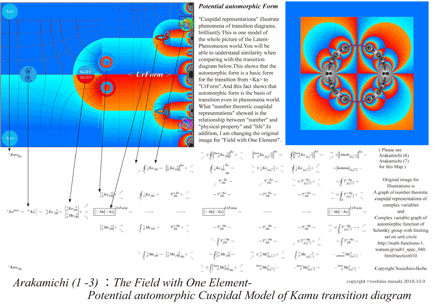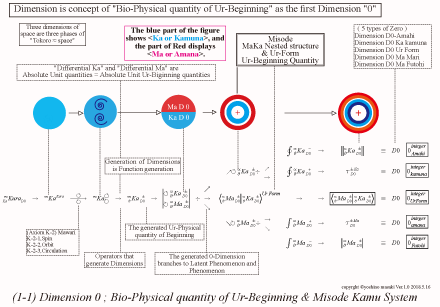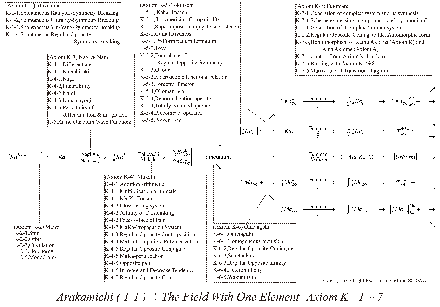Kamu Number Theory
| Contents |
|
Preface
|
| Summery |
|
1.Kamu Axiom system
|
|
2.Kamu Dimension system
|
|
3.Space Time compatible Quantum
|
|
4.Topological model of Ama Universe
|
| Kamu Number Theory |
| ver.2019.10 |
| Masaki Yoshino |
| Masaki Yoshino |
| site opned 2019.2.20 |
| studying Similarity schem theory from 1975 |
| copyright (c) 2019 all rights rezerved |
| blog in English and Japanese |
Spontaneous Regular-Opposite-Symmetry Breaking
Basic Principles of Kamu Number Theory
| New pdf 1-1-9.Futomani 1-1-8.Pair Production 1-1-7.Super Duality 1-1-6.Dyad 1-9-1.What is Ka ? 1-9-2.What is Ka & Ma 1-9-3.What is Ma ? |
| Chapter Index |
|
A4 size pdf Plate Index
|
| Preface |
| Summery |
|
|
|
1.Kamu Axiom System
|
|
|
|
1-1.Construction of Axioms
1-1-1.Axiom K and Axiom A 1-1-2.Field with one Element 1-1-3.Kamu Postulate |
|
1-2.Axiom from K1 to K8
1-2-1-1.K1,MaKaTama Symmetry 1-2-1-2.K1,spontaneous symmetry breaking 1-2-1-3.K1,UrForm and Prototype 1-2-2.K2,Mawari & Rotation 1-2-3.K3,differentiation and integration 1-2-4.K4,Kamu addition and multiplication 1-2-5.K5, Tokotachi Super Duality 1-2-6.K6, Pair Production 1-2-7.K7, Futomani 1-2-8.K8,Yata Phenomenon generation Field 1-2-9-1.What is Ka ? 1-2-9-2.What is Ma ? |
| 1-3.Axiom from A1 to A8 1-3-1.A1,Dynamic Saturation Stability 1-3-2.A2,Ama differentiation and integration 1-3-3.A3,Potential automorphic 4 Phases 1-3-4.A4,Tabane & Formal Power Series 1-3-5.A5,Imatachi & logic of Life. 1-3-6.A6, Compatibility and Duality 1-3-7.A7,Oho & Kamu forgetful Functor 1-3-8.A8,Kamuutsusi & Amautsushi |
| 1-4.Symboles inTransition Diaguram 1-4-1.First Reconsider the Operation 1-4-2.Compatible and Polymetric Additive operation 1-4-3.To Caputure Differenntial Integral with a wave image 1-4-4.Tranqull operation and Tropical Geometry |
| 1-5.Potential cuspidal automorphic form 1-5-1.Making an illustration of "Magatama Symmetry" of Axiom K-1 becomes Cuspidal automorphic form 1-5-2. Cuspidal automorphic form genetically dominating "Axiom A" |
| 1-6. Kamu imaginary Diamond and mirror symmetry 1-6-1. |
| 1-7. Axiom K-5 & 6 and the way to Carabi-Yau manifold 1-7-1. |
| 1-8. Carabi-Yau manifold to E8 Transition process and Axioms K8 |
| 1-9. Axiom A and Lie group U (1), SU (2), SU (3) |
| 1-10. Kamu Rosetta Stone |
| 1-11. Kurokawa multiple trigonometric function model |
| 1-12.Relativity-Capacitive-Quantity and Entropy 1-12-1.Reforming Boltzmann's Entropy definition formula and Information Thermodynamics 1-12-2.Guage Space and Relativity-Capacitive-Quantity |
| 1-13. Newton's map Model of Zeta function |
| 1-2-1-1. Axiom K-1 MaKaTama Regular-Opposite-Symmetry |
| Potential automorphic Cuspidal Model |
|
|
| First of all, the basic principle of Kamu Number Theory.Although the Axiom K-1 specifies the basic principle, it has three elements combined. |
| One is "Regular-Opposite-Symmetry", which is described in contrast to "chiral symmetry" used in physics for the sake of clarity.The second is "distortion of symmetry," which is explained in relation to "spontaneous symmetry breaking" in physics.Third, I will explain the relation with "complex number" about "UrForm" created by combining these two. |
| The combination of the above three elements is what we call "MaKaTama".I will explain the first "Regular-Opposite-Symmetry" here.This is a statement of the principle that "the symmetry is potentially positive and opposite pair symmetry". |
| I think this can be understood from the similarity with the automorphic form.The figure of the automorphic form shows a figure in which "white = positive and black = anti" figures transition symmetrically one after another. |
| My way of thinking is thus based on the similarity of shapes.This similar approach may seem to ignore the process of "mathematical proof".Certainly this is not a strict one, but I think it is the best one for global judgment. |
| The preservation form I thought of similarly corresponding to the transition diagram was Automorphic cuspidal form.So I tried overlaying the picture of this Automorphic cuspidal form with the transition diagram.The result was amazing. It responded to the overall structure and details of the transition diagram. |
| The Axiom K-1 indicated that the Automorphic cuspidal form potentially existed.Well, while looking at the map where the black and white symmetrical figures transition, what we have to think about is the phenomenon of Life. |
| Plate 1-1-1.AxiomK-1~ K-7 Transition |
 |
| Plate 1-1-3.Potential automorphic Cuspidal Model |
| Chiral symmetry is originally born from the observation of our right hand and left hand.Regular-Opposite-Symmetry has similarity with chiral symmetry.This observation, which started from looking at "white = positive = right and black = anti = left", must look at the whole phenomenon field. |
| For example, plus and minus, Arctic and Antarctic, right and left, latent and phenomena, light and dark, ancestry, and "men and women".Kamu Number Theory actively attempts to incorporate Life Phenomena into this "regular-opposite". |
| This is different from traditional science.So to speak, it is an extension of chirality symmetry to the Life domain under similarity.The discovery of S. Narasaki was complicated by the pairing of "positive and negative" biophysical properties that produce automorphic forms. |
| The “Life physical properties” of “positive-anti” are two directions of “Regular = Ma” and “Opposite = Ka”.This transitions to "Regular = phenomenon" or "Opposite = Latent-Phenomenon". |
| This Regular-Opposite-Symmetry is also the principle of the Similarity Scheme Theory.There is a principle that something similar to each other has a deep relationship behind it. |
 |
| pdf 1-1-4.Kamu-Calabi-Yau manifolds |
 |
| pdf 2-1-1. Dimension 0 ; Ur-Bigining |
 |
| pdf Axiom K System |
| New pdf 1-1-9.Futomani 1-1-8.Pair Production 1-1-7.Super Duality 1-1-6.Dyad 1-9-1.What is Ka ? 1-9-2.What is Ka & Ma 1-9-3.What is Ma ? |